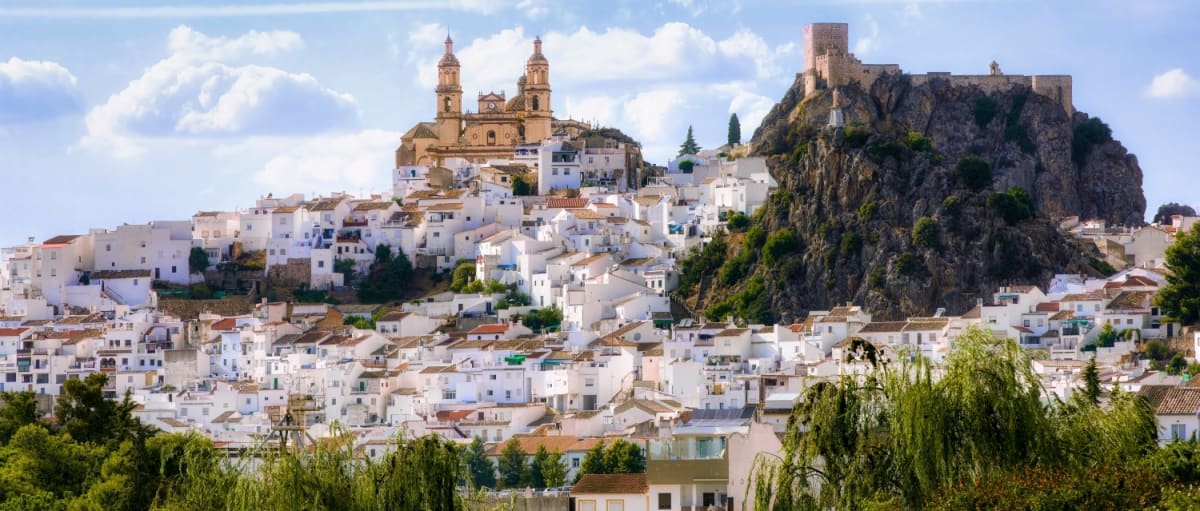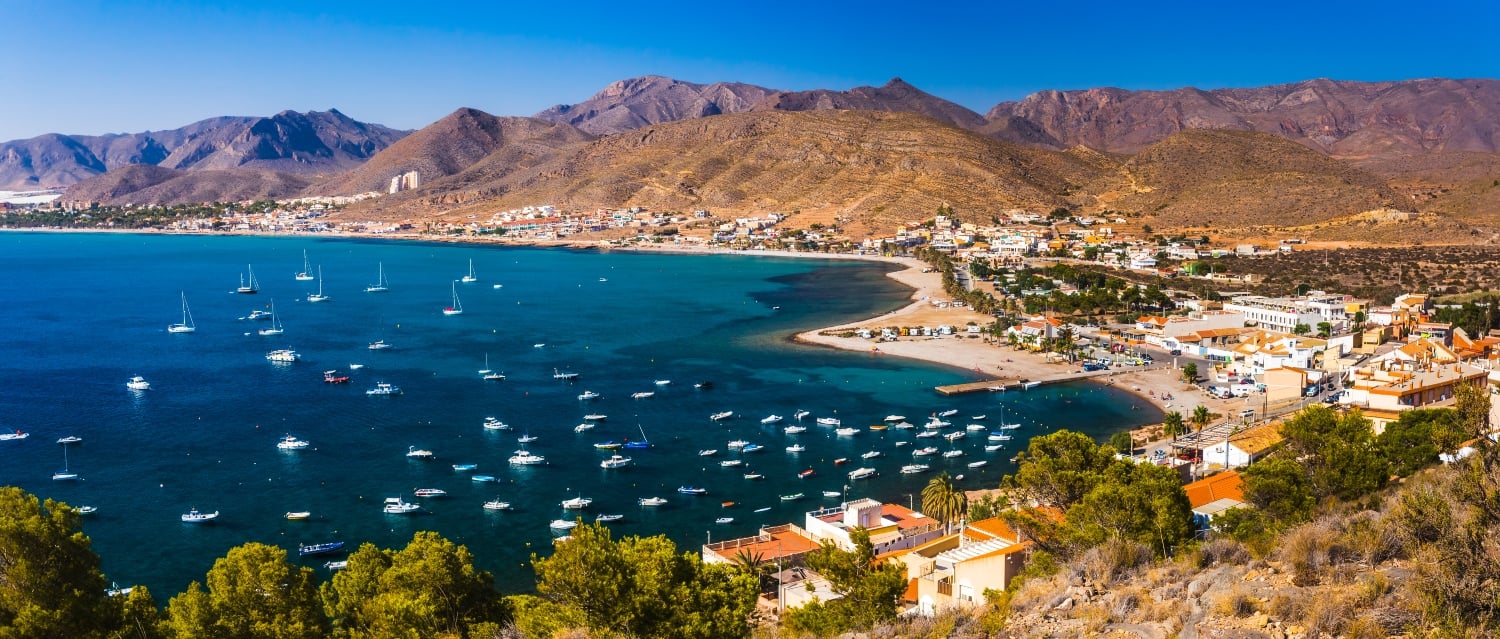Swimming in the calm, warm waters of the Mar Menor, sitting out in the sun in December, exploring the sleepy villages of the Espuña Mountains or visiting the bustling markets in Murcia and Cartagena – buying property in Murcia offers a dream lifestyle without the Costa del Sol price tag. With 3,000 hours of sunshine a year and some of the best-value homes in Spain, Murcia is becoming a go-to destination for overseas buyers seeking sun, space and affordability.
In this guide, you’ll discover what life is like in Murcia, the best places to buy, average prices and what types of properties are available – plus expert tips for making your purchase smooth and successful.
Download the Spain Buying Guide
Contents
Is Murcia a good place to buy property?
Unlike the more developed regions such as the Costa Blanca or Costa del Sol, Murcia, in southeast Spain, still offers plenty of space and tranquillity that’s getting harder to find elsewhere in Spain. Better still, property is more affordable here too.
It’s also well connected, with Murcia International Airport in Corvera offering year-round direct flights to major cities like London, Manchester, Glasgow, Dublin and other European cities.
What is it like to live in Murcia?
Life in Murcia is easygoing and relaxed, but far from dull. In the cities and towns, there’s a strong café culture, local markets and fiestas nearly every month. In the countryside, life centres around community, food and outdoor activities.

Climate
Murcia consistently ranks as one of the sunniest regions in Europe, with over 3,000 hours of sunshine a year and 150 days of clear blue skies. In summer, temperatures hit the late twenties, early thirties, while winters stay mild, averaging 11°C in January. That means outdoor living year-round – even in December you’ll be sipping coffee in the sun.
Cost of living
Murcia is known for its relatively low cost of living compared to other Spanish regions. Housing, dining and everyday expenses are generally quite affordable. The cost of living in Murcia City, for example, is 18.7% lower than Madrid, 22.2% lower than Barcelona and 5.3% lower than Malaga.
Nature and beaches
The region’s 73-kilometre coastline includes quiet sandy beaches, family-friendly bays and warm shallow waters ideal for swimming. This makes it the perfect place for families to swim and indulge in water sports.
Calblanque Regional Park is a favourite among walkers and cyclists – its protected landscape of dunes, cliffs and pine forests offers a wild, undeveloped stretch of coastline just minutes from the busier beach resorts.
Meanwhile, Cabo de Palos is perfect for a day out, whether you fancy a fresh seafood lunch by the harbour or a bit of snorkelling in the marine reserve.
Education and work
Murcia isn’t just for retirees and holidaymakers – it’s also a great choice for expats looking to start a new life, with plenty of opportunities for work and education.
The University of Murcia and UCAM (the Catholic University of San Antonio) bring a steady stream of international students, giving the city of Murcia a youthful, energetic feel. If you’re looking to work there, teaching English is a popular option, especially in private academies. There are also roles in tourism, real estate, remote working and even agriculture if you’re after a complete change of pace.
Festivals and events
Murcia’s calendar is packed with festivals that showcase its deep-rooted traditions, colourful history and strong sense of community. From religious processions to quirky parades and live music under the stars, there’s always something to celebrate. Here are some highlights to look out for:
Semana Santa (Holy Week)
One of the region’s most important religious celebrations, Holy Week is marked by solemn processions, elaborate floats and traditional music. The events in Murcia City, Cartagena and Lorca are especially well known for their grandeur and devotion.
Bando de la Huerta
A lively day during the Spring Festival, Bando de la Huerta honours Murcia’s agricultural past. Expect folk dancing, parades in traditional costume and plenty of local food and drink.
San Javier International Jazz Festival
Each summer, the coastal town of San Javier hosts some of the world’s top jazz musicians in open-air venues by the sea. It’s a relaxed, world-class event that attracts music lovers from across Spain.
Carthaginians and Romans Festival
Cartagena brings its ancient past to life every September with historical re-enactments, parades, mock battles and Roman camps. A fantastic one for history buffs.
Murcia Feria
Held every September, this traditional fair includes fairground rides, food stalls, concerts and plenty of late-night fun. It’s a great way to experience Murcia as the locals do.
Cuisine
Murcia has a strong culinary identity, with traditional dishes that reflect its agricultural roots and coastal influences. Local favourites include zarangollo – a simple but delicious mix of courgettes, onion and egg – caballitos, which are deep-fried prawns on skewers, and caldero, a rich rice and fish stew flavoured with smoky ñora peppers.
Thanks to its fertile lands and favourable climate, the region is also one of Spain’s top agricultural producers – which means fresh fruit and veg are always on the menu.
Where to buy in Murcia
Murcia’s property market has something for everyone. Its wide-ranging landscapes and lifestyles mean that no two areas feel the same – and that’s part of the appeal. Want to live near the sea? Prefer traditional village life? Need to be close to schools and services? You’ll find an area in Murcia that ticks your boxes. For overseas buyers, this diversity opens up real choice in terms of price, property type and pace of life.
Below, we explore some of the region’s most popular locations to help you narrow down where to focus your search.
The Costa Cálida
The “warm coast” lives up to its name with balmy water temperatures and calm, welcoming beaches. You’ll find resort towns like Puerto de Mazarrón and San Pedro del Pinatar alongside more laid-back fishing villages. The area is popular with retirees and holiday home buyers, particularly because prices remain lower than in the Costa Blanca to the north.
Many developments offer frontline beach apartments or modern villas with pools. Whether you want new-build convenience or a traditional Spanish bungalow, the Costa Cálida has something for everyone – often at prices that will surprise you. There are a wide range of properties in the region, from more traditional-style resales through to modern new-builds. Land here is still relatively affordable, so property prices are lower than further north along the coast.
La Manga

La Manga is a unique spot in Spain where you can swim in two seas – the Mediterranean and the Mar Menor – and enjoy both sunrise and sunset over the water. This 25km-long strip is lined with over 60 beaches, from the quiet Playa Dársena Dos Mares to the shady Cala del Pino. The Mar Menor, in reality akin to an enormous lagoon, is exceptionally calm. This makes it ideal for families with young children, as well as for boating and watersports. Plus, you can still swim in it in November, as the water warms much more quickly than the Mediterranean. Just inland, La Manga Club Resort offers world-class golf, luxury homes and strong rental appeal.
Los Alcázares
Located on the western shores of the Mar Menor, Los Alcázares blends the charm of a traditional fishing village with the convenience of a modern seaside resort. It’s long been a favourite with British buyers – and it’s easy to see why. The long promenade, sandy beaches and wide range of restaurants and shops make it a comfortable place to settle. With a friendly expat community and English widely spoken, it’s ideal if you’re looking for an easy transition into life in Spain.
San Pedro del Pinatar
Right on the northern edge of the Mar Menor, where the Costa Cálida brushes up against the Costa Blanca, you’ll find San Pedro del Pinatar – a town that offers the best of both coasts. It’s famous for its natural salt flats and therapeutic mud baths at Las Charcas, which attract visitors from across Europe. There’s also a lively marina, a good choice of shops and restaurants and easy access to airports and motorways.
Águilas
Águilas is a working port town with history, character and a spectacular coastline. With a population of around 35,000, it feels alive throughout the year – although it certainly shifts up a gear in summer when the population swells with holidaymakers. Its marina, sea-view promenade and wide sandy beaches give it classic Mediterranean appeal, while the surrounding hills and quieter coves offer a more peaceful escape.
Murcia City
This bustling city is the capital of its eponymous province, with a population of around 400,000 (similar in size to Cardiff or Leeds).
Grand baroque architecture dominates the centre and it has a gorgeous old town, full of pedestrianised, narrow streets to explore. Simple pleasures include sitting in one of the many terrace cafés, drinking a few cañicas and enjoying local tapas, like caballitos or pasteles de carne.
For those with children, Murcia is home to several international schools. El Limonar teaches to the British curriculum, as does King’s College. There’s also a British school following Montessori ideals on Calle Ermita Vieja.
The city is walkable, well-connected by tram and bus and very affordable.
Cartagena
Murcia’s second city is Cartagena, located by the sea. The busy port is still a working harbour and major naval base but also welcomes both cruise ships and yachts.
Cartagena has been ruled by many different civilisations, making it a fascinating city with remnants of times past, particularly the Roman Theatre of Carthago Nova. It also has some wonderful Modernist architecture dating from the early 20th Century, not to mention its lively pedestrianised streets. The centre is really around Calle Mayor, where you’ll find lots of shops, cafés and bars.
The surrounding coastal mountains are renowned for their botanical biodiversity and also the fauna, including eagles, falcons, wild boar, chameleon, bats, badgers and rabbits.
Inland Murcia
Looking for peace, nature and a slower pace? Murcia’s inland towns are full of character and charm. These are ideal for buyers wanting more space and value for money or a more traditional Spanish way of life.
Abanilla
For people who seek a more traditional Spanish way of life, Abanilla could be a good choice. It is a small town with little modern development so property for sale is mostly typically Spanish. Apartments are available but they don’t stay on the market for very long. The town has an expat community made up mostly of people from northern Europe and there are several good restaurants and bars. For many, the lack of nightlife is a blessing.
Calasparra
Calasparra has a large British community and a total population of over 10,000. It’s located in Murcia’s mountain region and the main crop here is rice thanks to it being crossed by four rivers. There are Anglican church services in the town and an online Calasparra Forum in English. During the past 15 years or so several modern developments have been built on the edge of the town which have attracted many foreigners and the British.
A few of the local shops will have British and other non-Spanish items for sale and finding English food is relatively easy here. Property is more expensive in the town than elsewhere in the region because of the high demand.
Lorca

With a population of 90,000, Lorca is the third-largest town in the region of Murcia. There is an old town, full of history and a modern downtown which serves every need. The historic district offers all sorts of bars, tapas bars and restaurants as well as some fine museums and galleries. There is a good transport connection with Murcia City and other regional locations.
Outside the town are Las Sierras de Lorca, where craggy outcrops and mountain ranges overlook fields and vineyards dotted with little villages – a world away from the developed coast but not that far away; it’s just a 40-minute drive to Aguilas to enjoy a swim. In fact, Lorca has 13 beaches to explore via the GR 92 (Great Footpath 92) running parallel to the coastline and which takes you across coves and dry riverbeds on natural paths.
| Location | Region | Highlights |
|---|---|---|
| Costa Cálida (La Manga, Los Alcázares, San Pedro del Pinatar, Águilas) | Coastal Murcia | Warm waters, family beaches, modern developments, luxury resorts |
| Murcia City | Central Murcia | Baroque architecture, schools, cultural life |
| Cartagena | South-east coast | Roman ruins, port city, lively centre |
| Inland towns and countryside (Albanilla, Calasparra, Lorca) | North-west and south-west | Traditional villages, nature, spacious properties |
Murcia property buying process
With the right help and advice, buying property in Murcia is a relatively straightforward process. Here’s what to expect and how to prepare:
Start your search online
Browse thousands of listings on the Your Overseas Home property portal to get a sense of what’s available across the Murcia region. Consider your must-haves – sea views, golf access, walking distance to the beach – and shortlist your favourite areas.
Build your team of experts
Once you’ve found a few properties you like, connect with a local estate agent who knows the area well. You’ll also need an English-speaking lawyer and a currency specialist like Smart Currency Exchange. A mortgage broker or financial advisor can also be helpful at this stage.
Speak to a Spain property expert
Plan a viewing trip
Seeing properties in person is essential before you commit. A viewing trip gives you the chance to explore the neighbourhoods and get expert advice on the ground. For tips on planning your visit, watch our Murcia property webinar:
Apply for an NIE number
Your NIE number is a foreigner identification number required to carry out any legal or financial transactions in Spain. You can apply through a Spanish consulate in your home country or at a police station in Spain. Your lawyer can help with this.
Open a Spanish bank account
Most property-related payments (like taxes and utilities) must be paid from a Spanish account. You’ll need your passport, proof of address and NIE. Some banks may also ask for proof of income.
Sign a reservation contract and pay a deposit
This usually takes the property off the market and shows your intent to buy. Ensure your lawyer checks the contract before signing.
Complete due diligence
This includes confirming legal ownership, checking land registry records, verifying planning permission and ensuring there are no outstanding debts on the property.
Sign the purchase contract
Also called the private purchase contract, this is signed by buyer and seller and typically involves paying 10% of the purchase price. The contract outlines timelines and legal obligations.
Sign the deed at the notary
The final step is signing the escritura pública (deed of sale) in front of a notary. You’ll also pay taxes and fees, and the property will then be officially registered in your name.
Types of property for sale in Murcia

There are many different types of property in Spain, and Murcia offers a fantastic variety. From stylish new-builds to rustic fincas tucked into the hills, there’s something here for every lifestyle and budget.
Here are some of the region’s most common property types and where you can find them:
| Property type | Description | Where to find them |
|---|---|---|
| New-build apartments | Modern, low-maintenance homes, often in secure resorts with pools and amenities | La Manga, Los Alcázares, San Pedro del Pinatar |
| Traditional villas | Detached homes offering space, privacy and classic Spanish architecture | Águilas, Calasparra, Mazarrón |
| Townhouses | Compact properties in towns and cities, ideal for easy upkeep | Murcia City, Mazarrón, Lorca |
| Fincas and cortijos | Rustic countryside homes, often with land; may need renovation but full of potential | Albanilla, Bullas, Fortuna |
Search homes for sale in Spain
Property prices in Murcia
Murcia remains one of the most affordable regions in Spain, but prices are steadily rising. According to the latest data from the National Institute of Statistics (INE), property values across the region have increased by 11.7% over the past year – just above the national average of 11.3% but below Andalusia, which saw the highest increase (13.4%). In Muria, the average price per square metre now sits at approximately €1,213, well below the national average of €2,226 – and considerably lower than what you’d pay on the Costa del Sol or in Madrid.
In popular coastal areas like La Manga and Los Alcázares, modern two-bedroom apartments are typically priced between €130,000 and €180,000, while in inland towns such as Calasparra or Bullas, you can still find traditional villas from around €90,000. City buyers will be pleased to know that Murcia City offers good value too, with reasonably sized apartments starting at €110,000 and rising based on location and amenities.
See our tips on how to find affordable property in Spain.
FAQs about buying in Murcia
Yes. Murcia’s prices are climbing, rental demand is increasing and developments like the expansion of La Manga Club show strong confidence in the region.
Absolutely – Spain welcomes buyers from all over the world. You’ll need an NIE number, a lawyer and, in many cases, a visa.
Yes, the region is generally considered a safe place to live and visit. Smaller towns and villages in particular have low crime rates and a strong community feel.
Download the Spain Buying Guide









